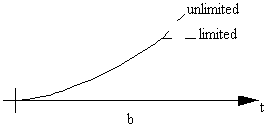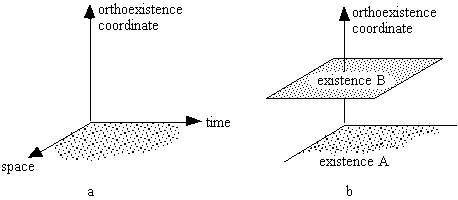Cases (a) and (a'), which are the last to
be examined, would imply that t = +infinite.
However, at least for reasons of symmetry, to which physical
justifications may be found, we cannot refute t = -infinite
and admit t = +infinite.That is why any
space-time existence is against its own finitetime.

Fig. 52

Fig. 53

Fig. 54
In a distinct image, we might represent a
synthetical coordinate of orthoexistence as "supplementary"
to space and time (Fig. 55). A like image springs from the manner
in which we understand things nowadays and might become a highly
unfaithful model of reality. A more accurate way to describe orthoexistence
might be entirely different, and so might the orthoexistence-existence
connections be. Nevertheless, we shall resort to the model illustrated
in Fig. 4a as it is beginning to draw the attention of contemporary
physicists and philosophers. Such a model suggests that two, or
even more, existences with their associated time and space (Fig.
55b) might spring from orthoexistence. So, there might exist hosts
of existences, which could not however be found within the same
space, i.e. in the sense of space-time existence. So far, we do
not yet know whether these existences are likely to be in touch
with another, or whether one could transgress the space and time
of our existence. In case any intercourse between existences is
precluded, we do not know whether a certain coupling via
orthoexistence is not likely to work. If such a coupling exists,
the conservation principle would then be valid for orthoexistence
and for the entire host of existences. Of course, the "laws
of nature " would then differ from one space-time existenceto another.
The universal motion of the total existence,
which is formulated in principle (XIII), is the ground to admit
some evolutions of space-time existences. Additionally, no space-time
existence will come to t = ±infinite.
A space-time existence unfolds each time against its own time,
which is always finite.
However, is the world compatible with t =±infinite?
The answer is both yes and no. First,let us note
that we do not know what time means outside space-time
existence. From the finite time of such a given existence, and
knowing that there are also other space-time existences which
may appear to be preceding or successive, the world may appear
as having an infinite time.

Fig. 55
We extrapolate the time of our existence with
respect to the existence of our universe, and know that outside
this time (which exists as long as this existence) there exist,
or there will exist, other experiences, and hence from this standpoint
we may say that the world is infinite in time ( from t = -infinite
to t = +infinite).
That is why we could state that the world is infinite or finite
in time (XIV).
The Philosophical Experiment
89









